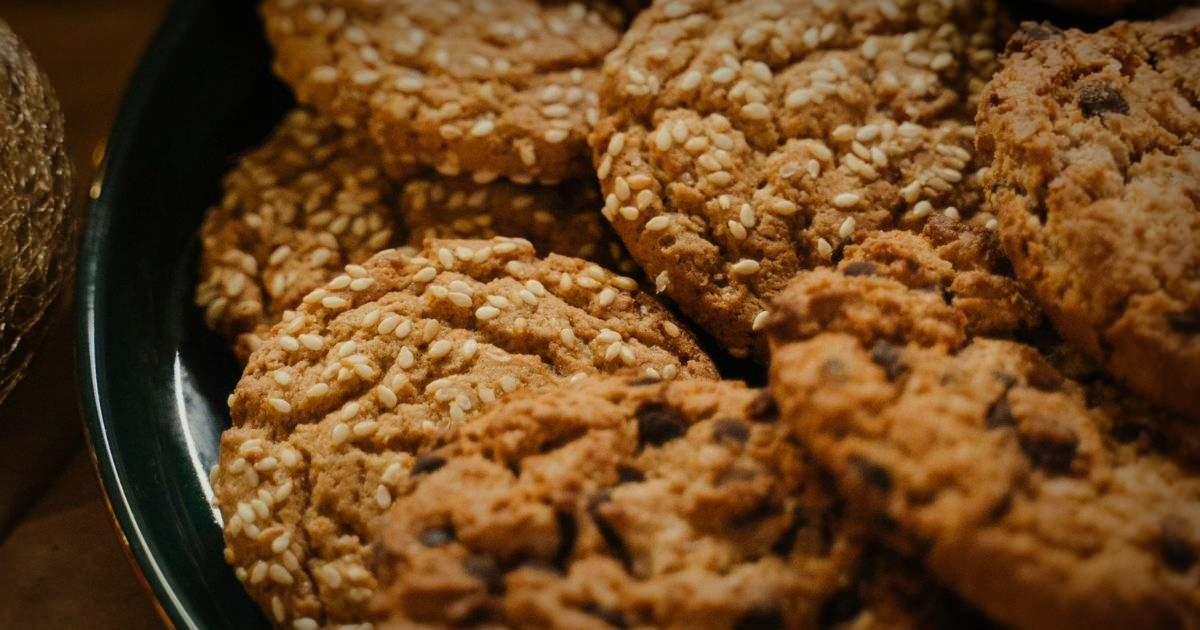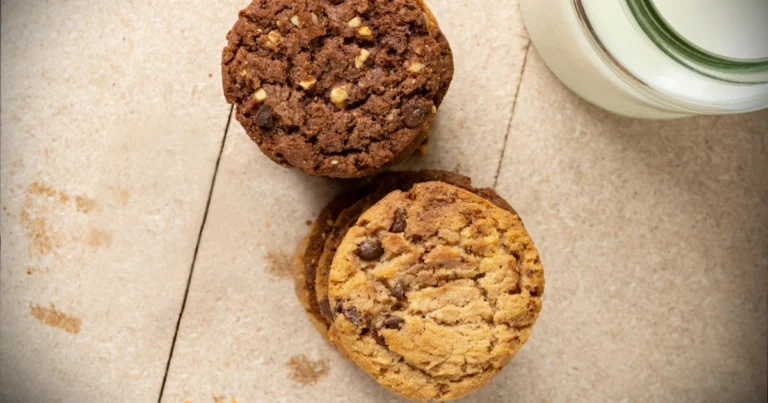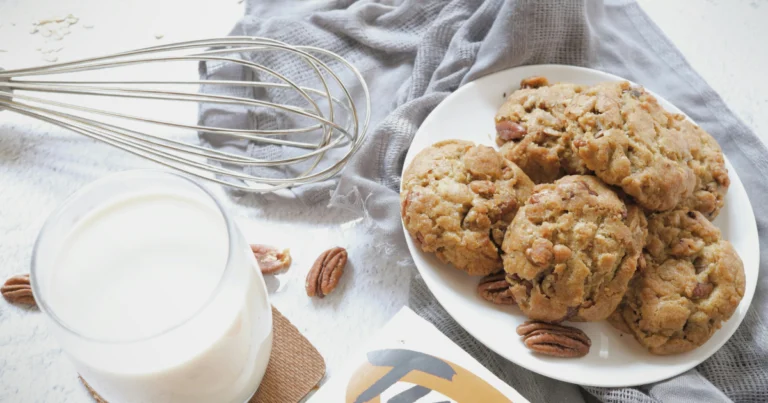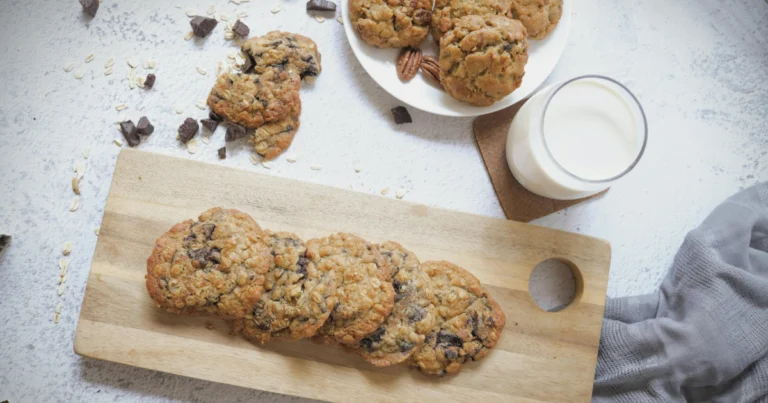Vanishing Oatmeal Cookies Recipe: The Secret to Soft & Chewy Cookies
Learn how to make oatmeal cookie recipe quaker-style treats that are incredibly soft. These cookies are so delicious, they disappear quickly. They’re made with Quaker Oats, blending classic tastes with a secret method for a chewy texture.f
This recipe suits both novice and experienced bakers perfectly. This recipe is perfect for beginners and experienced bakers alike. It teaches you how to avoid overbaking, so your cookies stay soft. You’ll need simple ingredients like Quaker Old Fashioned Oats, butter, and brown sugar. Let’s explore the science behind these irresistible cookies.
Table of Contents
Key Takeaways
- Vanishing oatmeal cookies use Quaker Oats for a signature chewy texture.
- No special equipment needed—just a mixing bowl and an oven.
- The recipe balances baking time to prevent crispiness, keeping cookies soft.
- Quaker-style oatmeal cookies vanish quickly due to their irresistible flavor.
- Follow precise steps for a foolproof batch every time you bake.
Introduction to Vanishing Oatmeal Cookies
Vanishing oatmeal cookies are more than just a snack—they’re a mystery. They change in the oven, mixing texture and taste in a unique way. Let’s discover what sets them apart.
Understanding the Unique Appeal
These cookies are loved for their soft, melt-in-your-mouth texture and rich taste. They’re different from other recipes because they mix oats, spices, and sweetness perfectly. Each bite is a mix of caramelized edges and a soft center.
What Makes Them “Vanishing”?
The name “vanishing” comes from their amazing change. Here’s how it happens:
- High fat content from butter or oil melts oats into the dough.
- Oven heat liquefies sugars, blending them with oats smoothly.
- No oat chunks are left—only a smooth, cake-like inside.
This process makes the cookies feel lighter but more indulgent. After baking, you’ll see why they’re called “vanishing.” The texture surprise is worth it.
Ingredients and Essential Equipment
Creating the perfect vanishing oatmeal cookie starts with the right ingredients and tools. Let’s explore what you need for that signature melt-in-your-mouth texture.
Ingredients:
- Butter: Use unsalted butter for better flavor. It adds richness and meltiness.
- Brown Sugar: It’s key for moisture. Choose light or dark brown sugar based on your taste.
- Eggs: Use room-temperature eggs for smooth mixing. This ensures an even texture.
- Old-Fashioned Oats: Quaker Old Fashioned Oats are best. Rolled oats keep moisture without getting soggy.
- Baking Soda: It helps the cookies rise just right without spreading too much.
Baking Tools:
- Stand Mixer or Hand Mixer: These whip ingredients for a fluffy batter.
- Silicone Spatula: It’s great for scraping bowls and folding ingredients gently.
- Non-Stick Baking Sheet: It prevents cookies from burning or sticking.
| Ingredient | Role in Texture | Recommended Brand |
|---|---|---|
| Old-Fashioned Oats | Maintains chewiness | Quaker, Bob’s Red Mill |
| Granulated Sugar | Crystallizes edges for slight crunch | C&H or Domino |
| Vanilla Extract | Enhances flavor complexity | McCormick or Nielsen-Massey |
Pro tip: Always measure flour with a spoon and level method to avoid overpacking—this prevents dryness. Quality ingredients like real vanilla and fresh baking soda ensure optimal results.
Baking Process: Step-by-Step Guide
Turning simple ingredients into delicious oatmeal cookies with instant oatmeal requires careful steps. Each step affects the cookie’s texture and taste. So, it’s important to pay close attention to timing and technique.
Preparing Your Workspace and Preheating
Start by clearing your counters and getting your tools ready. You’ll need parchment-lined baking sheets, a spatula, and a timer. Heat your oven to 350°F (175°C) and arrange the dough on trays. A hot oven ensures cookies cook evenly.
Remember, place racks in the oven’s center for even heat. This helps your cookies bake perfectly.
Mixing Techniques and Timing Tips
Use a stand or hand mixer to mix softened butter and sugars until they’re light and fluffy. Add vanilla and eggs one at a time, scraping the bowl after each. Then, mix in dry ingredients, like instant oatmeal, just until they’re combined.
Scoop 1.5-inch balls of dough onto parchment, leaving 2 inches between each cookie.
- Preheat your oven first to avoid dough resting too long.
- Measure oatmeal precisely—too much makes dough thick, too little makes it less chewy.
- Bake for 10–12 minutes until edges are lightly brown but centers are still soft.
Let cookies cool on the sheet for 2 minutes before moving them to a wire rack. This step helps keep them moist. If edges burn easily, adjust oven temperature by ±5°F.
Tips for Achieving Perfect Soft & Chewy Cookies
Even with the best ingredients, small changes can make a big difference. These tips will help you make cookies that are soft and chewy:
Mastering Temperature and Texture
Getting it right is all about precision:
- Set your oven to 350–375°F but check with a thermometer. Ovens can be off.
- Keep an eye on cookies in the last 2–3 minutes. They should look a bit underbaked.
- Let the dough rest for 10–15 minutes before baking. This helps cookies stay thick and chewy.
Integrating Additional Ingredients for Flavor
Adding flavor without losing texture is key:
- Use vanilla or almond extract for extra taste, or add 1/4 cup dark chocolate chunks for richness.
- Try a teaspoon of sea salt or a pinch of cinnamon to balance sweetness. But too much can dry out the dough.
- Test new ingredients in small batches first. Too many nuts or dried fruits can make cookies crack.
Troubleshooting Common Baking Challenges
Even the best bakers sometimes hit roadblocks. If your cookies spread too thin or lack chew, making small tweaks can help. Here are tips for common problems:
- Spreading batter? Too much mixing or warm melted butter can cause spreading. Try chilling the dough for 20-30 minutes to firm it up. Test this: refrigerate half the dough and bake batches side-by-side to see the difference.
- Uneven browning? To avoid this, rotate your cookie sheet halfway through baking. If your oven has hot spots, use an oven thermometer to check the temperature. A small difference in temperature can affect the texture.
- Dry centers? Lower the oven temperature by 15-25°F and bake for 1-2 minutes longer. Overbaking dries out cookies—check them at the minimum baking time. They will harden as they cool down.
Use parchment paper to prevent cookies from sticking, not extra flour which can make them crusty. If edges burn before the centers are done, line pans with silicone mats for even heat. Always measure oats carefully: old-fashioned rolled oats (not quick-cooking) give the right texture. Choose pure vanilla extract for the best flavor—avoid imitation brands.
Creative Variations for Your Oatmeal Cookies
Ready to elevate your oatmeal cookies? Try new textures and flavors while keeping them soft. Experiment with different oats, add-ins, or methods to find new favorites.
Oatmeal Cookie Recipe Quaker Style
Quaker Oats add a hearty texture. Swap rolled oats for Quaker Old Fashioned Oats. Mix in raisins, cinnamon, and a dash of vanilla. Chill the dough for 30 minutes for firmer edges.
Exploring Oatmeal Cookies with Instant Oatmeal
Instant oats make cookies denser. See how they compare:
| Comparison | Old Fashioned Oats Cookies | Instant Oatmeal Cookies |
|---|---|---|
| Texture | Crispy edges, chewy center | Moist and fudgy |
| Bake Time | 12-14 minutes | 10-12 minutes |
Old Fashioned Oats Cookies Twist
Customize old fashioned oats cookies with these ideas:
- Add chocolate chips and sea salt for salty-sweet contrast
- Stir in coconut flakes for tropical flair
Always use fresh baking soda/powder for best rise. Adjust add-ins by ¼ cup to avoid spreading.
Conclusion
Making vanishing oatmeal cookies requires careful steps and quality ingredients like Quaker oats. By following the baking process, each batch stays soft and chewy. This is thanks to proper mixing and oven timing.
Adding ingredients like cinnamon or dark chocolate chips brings extra flavor. But it doesn’t change the cookie’s texture. Adjusting the brown sugar or butter can also keep the cookies soft.
Using the right tools, from mixing bowls to parchment paper, is key. Now, are you ready to bake? Get your supplies and start mixing. These cookies disappear fast, so enjoy them while they’re warm.
Whether you’re making the classic recipe or adding your own twist, every bite is special. Your kitchen’s next hit is waiting for you. Try it today and see why these treats are so hard to resist.
FAQ
What makes the vanishing oatmeal cookies so soft and chewy?
The secret is in the mix of ingredients and how you mix them. Brown sugar adds moisture. Following some baking tips helps get that soft texture.
Can I use instant oatmeal for this cookie recipe?
Yes, instant oatmeal works great for oatmeal cookies. Just keep in mind it might change how the cookies absorb moisture, affecting the texture.
What is the difference between old-fashioned oats and quick oats in cookie recipes?
Old-fashioned oats give a chewier cookie with a rustic look. Quick oats make a softer cookie. Your choice will change the cookie’s texture and look.
How do I store my oatmeal cookies to maintain freshness?
Keep your cookies fresh by storing them in an airtight container at room temperature. For extended storage, consider freezing them.
Can I add chocolate chips or nuts to my oatmeal cookie recipe?
Absolutely! Adding chocolate chips, raisins, or nuts can make your cookies even tastier and more interesting.
What are some variations I can try with my oatmeal cookie recipe?
Try different variations like using Quaker oats, instant oats, or old-fashioned oats. Each offers a unique taste.
How do I ensure my cookies bake evenly?
For even baking, preheat your oven well. Use an oven thermometer to verify the temperature, and rotate your baking sheets midway through baking.Use an oven thermometer to check the temperature. Also, rotate your baking sheets halfway through baking.
Can I make these cookies gluten-free?
Yes, you can make gluten-free oatmeal cookies. Opt for certified gluten-free oats and a gluten-free flour blend as a substitute for all-purpose flour. Use certified gluten-free oats and a gluten-free flour blend instead of all-purpose flour.






